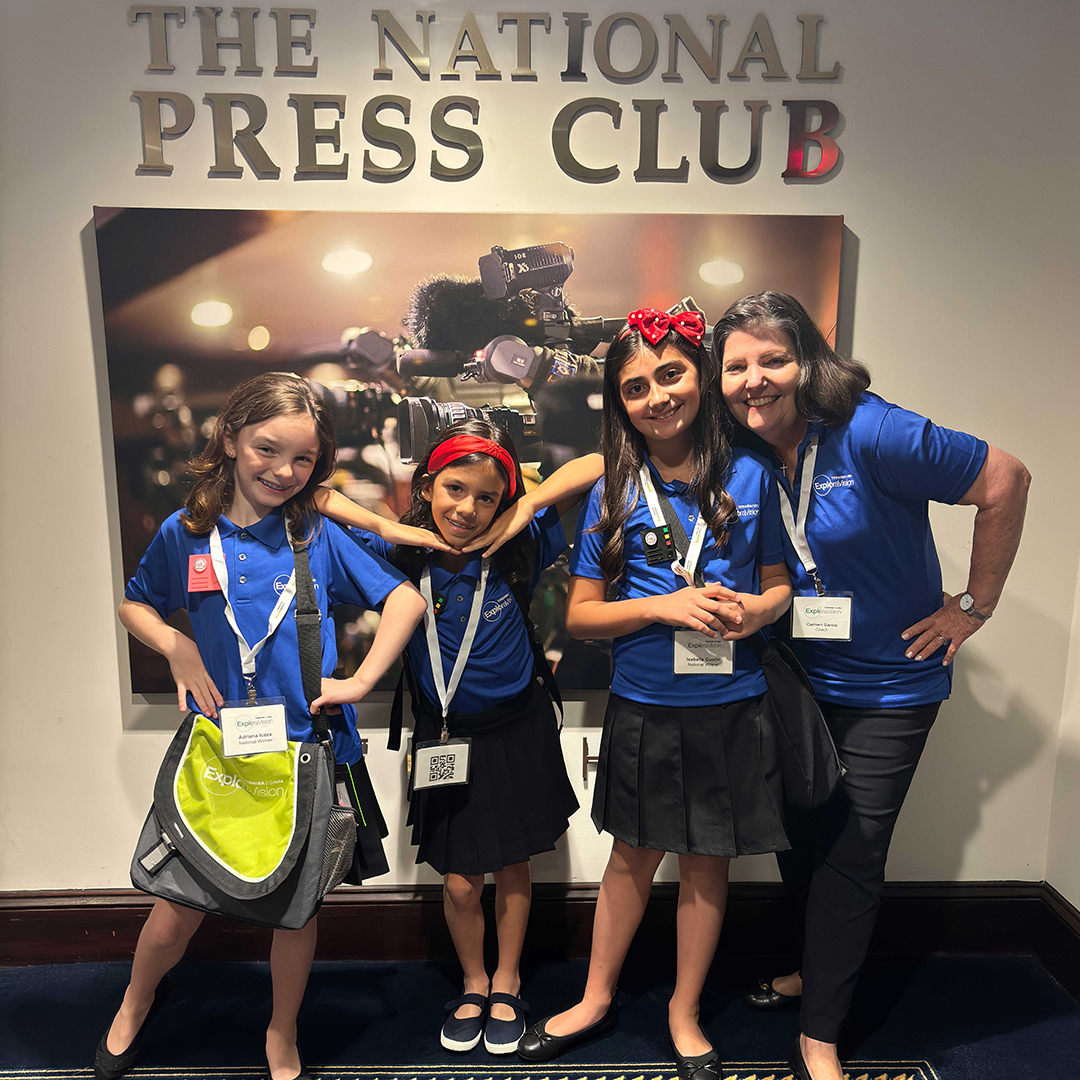By Cristina Cabrera Jarro -
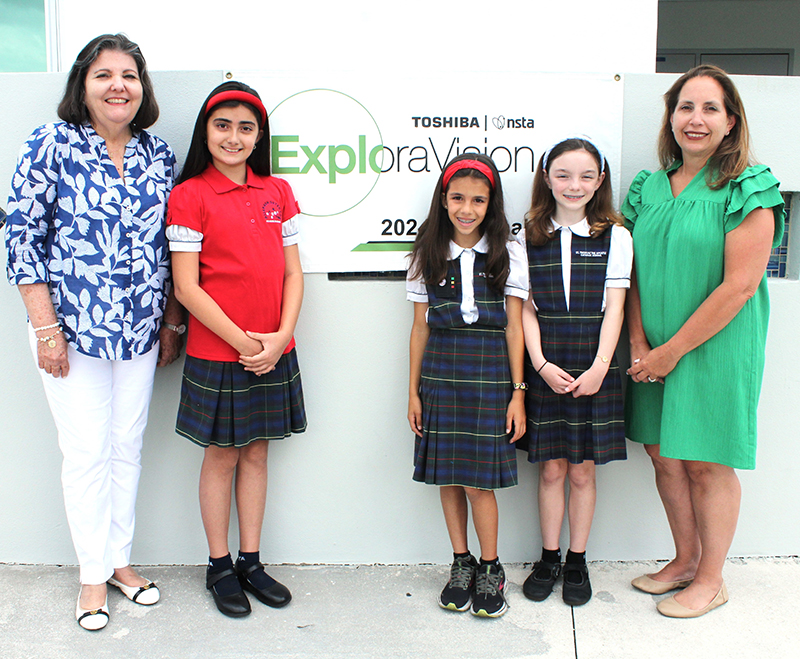
Photographer: CRISTINA CABRERA JARRO| FC
St. Thomas the Apostle School staffers Carmen Garcia, left, and Ana King, right, flank third graders Isabella Gustin, second from left, Emilia Martinez Christensen and Adriana Icaza, the team who created “The Allergen Detector” project that won first place in the 2024 Toshiba/NSTA ExploraVision Science Competition in the kindergarten through third grade division. (CRISTINA CABRERA JARRO | FC)
MIAMI| Worried about food allergies? Third graders Adriana Icaza, Emilia Martinez Christensen and Isabella Gustin from St. Thomas the Apostle School in Miami want to help you stressless about your meals and enjoy a bon appétit, thanks to their invention: the Allergen Detector.
“It’s a scanner that clips to your shirt, and it identifies whether the food you are about to eat is safe or not, according to your allergies,” said Adriana.
The theoretical science project earned the trio a first place in the kindergarten through third-grade division of the 32nd Annual Toshiba/NSTA ExlporaVision Science Competition.
“We won,” the girls happily announced in a school Instagram post in early May.
Each student was awarded a $10,000 U.S. EE Savings Bond (at maturity), a new laptop, and a trip to Washington, D.C. from June 13-14 hosted by Toshiba/NSTA ExploraVision for their national winners.
“I really want to go inside the Capitol. It’s beautiful,” Adriana told the Florida Catholic in an interview before the trip.
Once in D.C., the girls toured the historic building, and even had the opportunity to meet with Congresswoman Maria Elvira Salazar.
During their trip, they were also invited to the National Press Club and participated in a press conference for this year’s Toshiba/NSTA ExploraVision winners. Later, they presented the Allergen Detector to an audience that included Taro Shimada, president and CEO of Toshiba, Bill Nye the Science Guy, Justin “Mr. Fascinate” Shaifer, and others.
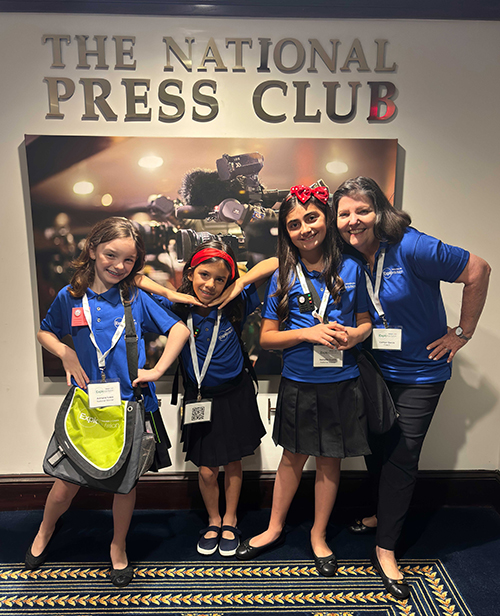
Photographer: COURTESY PHOTO
From left: third graders from St. Thomas the Apostle School in Miami, Adriana Icaza, Emilia Martinez Christensen, Isabella Gustin, and teacher Carmen Garcia, pose on June 14, 2024, after the media presentation of their invention, the Allergen Detector. The idea won first place in the kindergarten through third grade division of this year's Toshiba/NSTA ExploraVision Science Competition, which included a trip to Washington, D.C.
Over the last few years, St. Thomas the Apostle School has participated in this annual science competition. This year, another group from the school received an honorable mention for their HOLOSERVER AI project, and in 2018, students earned second place at the national level for their Smart Toilet invention.
Our Lady of Lourdes Academy, another archdiocesan school, also won four honorable mentions for projects submitted this year.
Brainstorming a project that helps
The largest kindergarten through 12th grade STEM competition in the world, ExploraVision calls for students to collaborate to solve real world problems by envisioning future technology inspired by current science. Once an idea or invention is selected, the project must be presented in a format that includes an abstract, description, bibliography, and web page presentation, similar to a PowerPoint presentation.
At St. Thomas the Apostle School’s Saint Elizabeth Ann Seton program for exceptional students, teams began their brainstorming in September 2023.
“This is a Language Arts class where we learn to write a science project within the class,” said teacher and coach Carmen Garcia.
“It was really hard,” said Adriana.
Even so, Garcia said watching the kids learn how to conduct research through Google was special.
“It was magical when they found new technology,” she said.
More important than the invention, Garcia reminded students that their goal was to help other people.
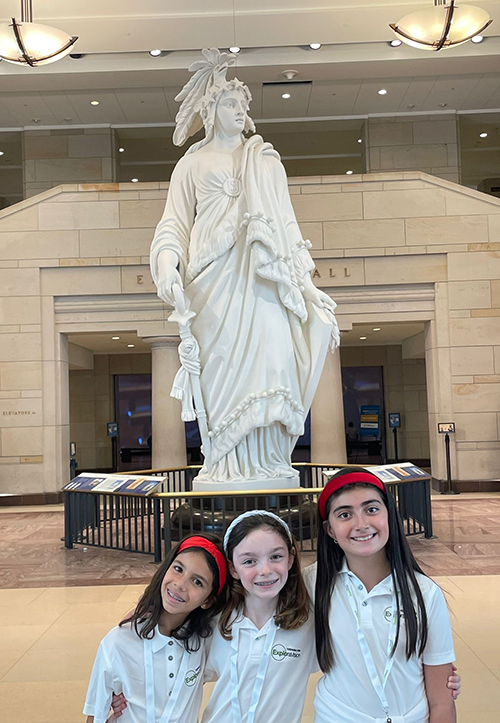
Photographer: COURTESY PHOTO
From left: Emilia Martinez Christensen, Adriana Icaza, and Isabella Gustin of St. Thomas the Apostle School in Miami enjoy sightseeing during their Washington, D.C. trip, June 13-14, 2024, including this stop to the visitor center of the U.S. Capitol Building featuring the Statue of Freedom behind them. The trip was one of the prizes for winning the Toshiba/NSTA ExploraVision Science Competition.
After interviewing family and friends, Adriana, Emilia and Isabella discovered that a common challenge many of them faced was food allergies. Meals and snacks were stressful because of the concern over the possible use of milk, nuts, shellfish, sesame, and other ingredients that they were allergic to.
“At school, I see that lots of kids are worried about what they are about to digest of the foods,” said Isabella.
To note, St. Thomas the Apostle School is a peanut free school, and they take the necessary precautions with meal prep. But the girls kept wondering how else they could help.
Eventually, they thought of a small wearable scanner that could identify foods and detect allergens through the use of visual and scent technology. They called it the Allergen Detector.
“The scent technology smells the odor molecules to see if the allergen is detected, and the visual technology is almost like Google Lens, so it sees the food and it absorbs it,” Emilia explained.
The device is also multilingual and can be used to read an ingredient list or QR codes in different languages found on prepackaged foods. It pairs to an app, via Bluetooth, and users can create a profile to submit necessary allergen information. When the Allergen Detector scans, a light on the device will flash green if it is okay to eat, or yellow or red if it is not.
According to Garcia, scientists are currently looking to advance scent technology.
“We read that in years to come, you’re going to be able to look at a recipe, or someone cooking on TV or online, and you’re going to be able to smell it. We turned the technology around, and we applied it to our invention,” Garcia said.
In February, the team submitted the Allergen Detector project to compete in the regional division of ExploraVision. On April 1, they were announced as winners and qualified for the national level, which additionally required a video presentation and a Canva poster to be submitted by May 6.
It became a community project, with the girls’ families and friends helping with video production, logo designing, shirt making, 3-D printing of the actual device, and more.
“I think because the girls were so detail-oriented, Mrs. Garcia was so detailed about explaining things, they were organized, and they went that extra step, it really did help the team,” said Ana King, St. Thomas the Apostle School teacher who also helped.
After almost an entire academic year of creativity and patience, the girls were announced as the ExploraVision national winners at the end of May.
“My mom thought that it’s crazy that we’re eight and nine years old and already making something like this for the future, that no one has created,” said Isabella.
Still, like The Jetsons cartoons that they watched for futuristic inspiration, Adriana points out “Our technology will someday be on the market.”
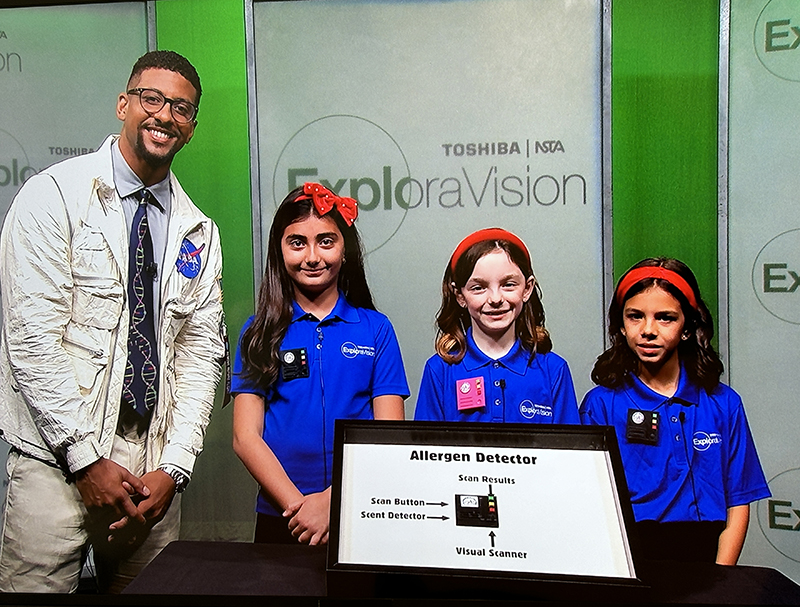
Photographer: COURTESY PHOTO
Isabella Gustin, second from left, Adriana Icaza and Emilia Martinez Christensen, third graders from St. Thomas the Apostle School in Miami, pose June 14, 2024, with Justin “Mr. Fascinate” Shaifer during a media presentation of their invention, the Allergen Detector.
